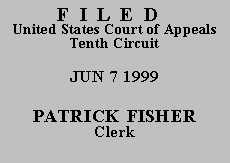

| UNITED STATES OF AMERICA,
Plaintiff-Appellee,
v.
AARON KEITH HUBBARD, also
known as Aron Keith Hubbard Defendant-Appellant. |
No. 98-7130
(D.C. No. 98-CR-14-B) |
The story begins with a burglary on the night of August 20, 1997, of Muskogee Metal Fabricators, Inc., which included the theft of thirteen firearms, a number of them recovered during subsequent investigations. On January 21, 1998, Johnny Brooks, arrested on other charges, stated that he, Jimmy Tucker and Mr. Hubbard were the Muskogee Metal burglars. He advised that he had taken a .45 derringer from the Muskogee Metal robbery and had given it to Mr. Hubbard, who traded it to Alfred Lee Alley for drugs. Mr. Brooks also advised that Mr. Hubbard himself had taken several firearms during the robbery, including a Ruger, 9mm pistol and a .38 caliber revolver. Mr. Brooks stated that Cheryl Woodall had sold a Mini 14, .223 caliber semi-automatic rifle to Mr. Hubbard for bail money, and that Mr. Brooks had seen the rifle at Mr. Hubbard's residence in November 1997. Mr. Brooks advised that Mr. Hubbard was "very fond" of the Mini and that it "would probably remain in his possession." Rec., vol. I, doc. 1, Affidavit at 3. Cheryl Woodall corroborated that she had sold "some rifles" to Mr. Hubbard to obtain bail money for Alfred Lee Alley. Id. at 4.
Based on the investigation and, in particular, the information provided by Mr. Brooks, Agent Sandoval made an affidavit and an application for a search warrant for Mr. Hubbard's residence. The application described the property to be seized as, among other items, "[a]ny and all firearms, to include but not limited to, one (1) Ruger, mini 14, .223 caliber semi-automatic rifle. An unknown make or model .38 caliber revolver. Any items pertaining to the possession and/or disposition of any firearm, including gun case, ammunition, spare parts for firearms." Rec., vol. I, doc. 1, Attachment B. A search warrant was issued on February 3, 1998, a search conducted on February 12, and two guns, a hand grenade, explosive materials and various types and quantities of ammunition were seized.
Mr. Hubbard contests the validity of the search warrant. In reviewing the district court's denial of a motion to suppress, we review the district court's findings of fact for clear error, and we view the evidence in the light most favorable to the government. See United States v. Sanchez, 89 F.3d 715, 717 (10th Cir.1996). The overall reasonableness of a search is a question of law that we review de novo. Id. To assess the validity of a search warrant under the Fourth Amendment, we review whether the totality of the circumstances set forth in the affidavit "provided the judicial officer a substantial basis for finding a fair probability that contraband or other evidence of a crime would be found at the searched premises." United States v. McCarty, 82 F.3d 943, 947 (10th Cir. 1996) (quotations omitted); United States v. Sturmoski, 971 F.2d 452, 457 (10th Cir. 1992).
Mr. Hubbard first contends the search warrant lacked probable cause because the evidence leading to the warrant was stale. He argues that any evidence of guns he had taken during a robbery in August, six months before the search warrant, or any evidence he had traded bail money for rifles in November, did not sufficiently suggest that he would be in possession of guns in February. We disagree. In reviewing for staleness, we look at the nature of the offense and the length of criminal activity, "not simply the number of days that have elapsed." United States v. Myers, 106 F.3d 936, 939 (10th Cir. 1997). Indeed, "[w]here the offense in question is ongoing and continuing, the passage of time is not of critical importance." United States v. Le, ___ F.3d ___, 1999 WL 176192, at *6 (10th Cir. Mar. 31, 1999) (quotations omitted) (citing Sturmoski, 971 F.2d at 457). The statements from Mr. Brooks on January 21 that Mr. Hubbard probably still possessed the Mini and that Mr. Hubbard engaged in an on-going pattern of exchanges for firearms, viewed in the totality of the circumstances, convinces us there was sufficient probability of existing evidence of a crime to support the search warrant.
Mr. Hubbard next contends that the search warrant was deficient because it failed to state the items to be seized with sufficient particularity, its main flaw being the inclusion of an "unknown" .38 that the government should have specified as the missing .38 from the robbery. Mr. Hubbard cites United States v. Leary, 846 F.2d 592, 600 (10th Cir. 1988), for the proposition that the government's failure to list this specific gun makes the warrant deficient. Contrary to Mr. Hubbard's interpretation, Leary stands for the more flexible proposition that "[t]he test applied to the description of the items to be seized is a practical one" where specificity or generality must be customized to the nature of the activity under investigation. Id. In the instant case, the listing of the general make of the gun was appropriately particular. Since Mr. Hubbard was a felon, any firearm in his possession would constitute an offense. Moreover, evidence was proffered that he engaged in ongoing firearm trading. The warrant, asking for all firearms while listing specific makes, was generic enough to fit the purposes of the investigation of a felon possessing guns while also being particular enough to assure no general rummaging by police.
In conclusion, we AFFIRM the judgment of the district court.
ENTERED FOR THE COURT
Stephanie K. Seymour
Chief Judge
*.This order and judgment is not binding precedent, except under the doctrines of law of the case, res judicata, and collateral estoppel. The court generally disfavors the citation of orders and judgments; nevertheless, an order and judgment may be cited under the terms and conditions of 10th Cir. R. 36.3.